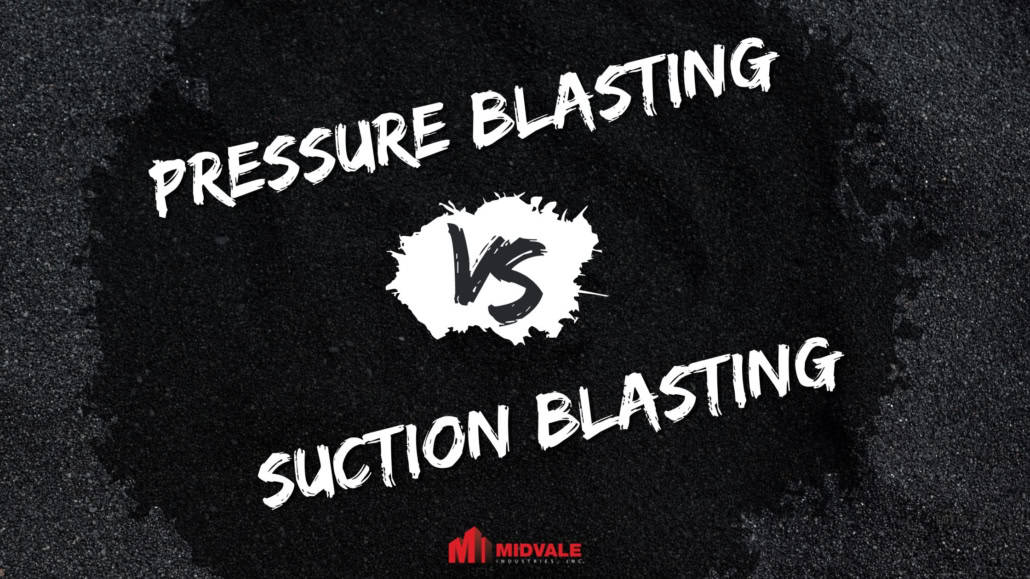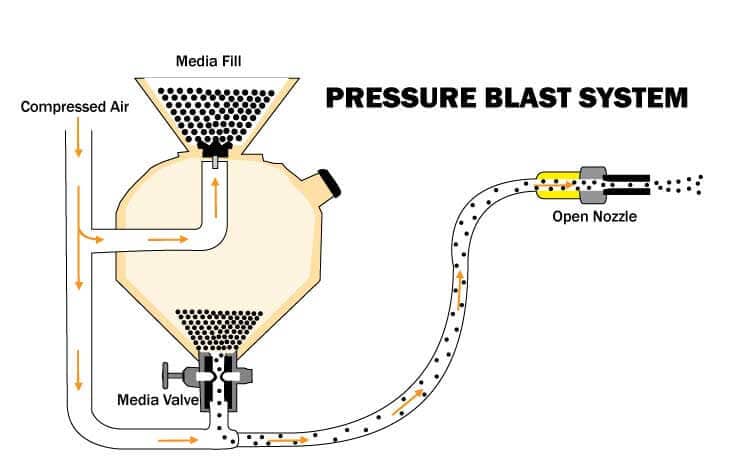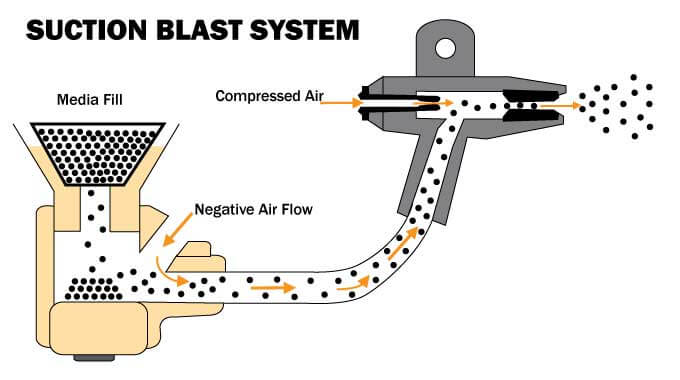Pressure Blast Cabinet vs. Suction Blast Cabinet
Abrasive blasting is a versatile process used to clean or prepare surfaces for various applications. Choosing the right equipment and media is crucial for a successful project. This guide will focus on the two primary types of abrasive blasting systems: pressure blasting and suction blasting (also known as siphon blasting). Let’s explore the advantages and disadvantages of each method to understand which one best fits your needs.
Pressure Blast Cabinet
Pressure abrasive blast equipment utilizes a pressurized vessel and meters the media into a flow of compressed air, propelling the media onto the blasting surface. The media is processed in a single, heavy-gauge hose with the blast particles being accelerated throughout its length.
Advantages of a Pressure Blast System
- Higher media velocity
- Greater media volume
- Faster blast cycles
- Wider variety of abrasive options
- Increased standoff distance flexibility
Disadvantages of a Pressure Blast System
- Higher capital equipment costs
- Higher maintenance costs
- Limited continuous blast cycle time
Typical Pressure Blasting Applications
- Removing heavy coatings, such as paint, rust, and scale
- Preparing surfaces for painting or powder coating
- Cleaning and roughening concrete surfaces
- Removing graffiti
- Shot peening metal parts to improve their fatigue life
Suction Blast Cabinet
Suction blast cabinets are distinguished by having two hoses (one for air and one for abrasive) running to the blast gun. Utilizing air pressure, a suction gun pulls the media from a hopper through the hose for blasting. The media is mixed with the air at the blast gun.
Advantages of Suction Blast System
- Lower capital equipment cost
- Easier maintenance
- Less air and abrasive demand
- Continuous blasting is possible
Disadvantages of Suction Blast System
- Frequent Media Changes
- Limited Repeatability
- Adjustments to Media Volume and Flow Cannot be Positively Indexed and Locked-In
Typical Suction Blasting Applications
- Cleaning delicate surfaces, such as wood and plastic
- Removing light coatings, such as dust and dirt
- Sandblasting glass
- Preparing surfaces for bonding or painting
- Etching metal parts
Choosing the Right Blasting Method
When you are choosing which abrasive blasting method to use, there are several factors that you need to take into consideration: surface type, desired finish, parts volume per hour, media restrictions, budget, and safety.
Surface Type: The type of metal you’re blasting may affect your blasting options, as well as the contaminant/coatings you are removing. If there is a thick coating or heavy cleaning to be done, pressure is ideal. If there is a thin coating or less aggressive cleaning required, suction is an ideal solution.
Volume: Do you have a small or large volume of parts to finish each day? Do you have need to blast 1 hour per day or constantly over two shifts? If the former, suction blasting may be just fine. For the latter, the speed and efficiency of pressure blasting is a must.
Budget: Evaluate your budget and long-term operating costs. Pressure blasting systems may have a higher initial investment but can result in cost savings over time due to material recycling.
| Characteristic | Pressure Blast Cabinet | Suction Blast Cabinet |
|---|---|---|
| Speed | Faster | Slower |
| Aggressiveness | More Aggressive | Less Aggressive |
| Cost | More Expensive | Less Expensive |
| Ease of Operation | More Difficult | Easier |
Time To Evaluate
Both pressure blasting and suction blasting are great options for various metal finishing needs. Ultimately, your decision is going to come down to the needs of your project and your budget. Understanding the differences and the main uses of each blasting process, and the requirements of your parts, you’ll be able to evaluate and select the process that will best fit your blasting operation.
If you’re interested in finding out more information on abrasive blast equipment or running tests on your parts, contact our team today.







